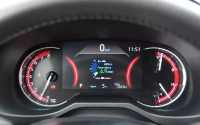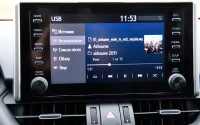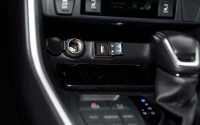We drove the Japanese crossover on busy highways, dirt roads, and off-roads. Our terrain quickly showed all the advantages and disadvantages of the Rafik.
Dynamics: does not squeeze into the seat
We have taken for test the all-wheel drive RAV4 in a complete set Style with the petrol engine of 149 h.p. and a variator. Do not expect from this Toyota impressive pickups and overloads of the vestibular apparatus. But it will lay out the passport 11 seconds in acceleration up to a hundred, and in "sports" mode it will even give acceleration some emotional coloring and "buzz" from driving at increased revolutions.
But on the whole, it's kind of boring. Such is the payback for rather useful ideology "rational, economical, and durable". Under a cowl of the crossover there is the 2-liter anti-downsizing atmospheric motor with the combined system of injection, variable phases of intake and chain drive of the gas distribution mechanism.
Resource! How sweet it sounds in the age of small cubic meters. The atmospheric engine itself is able to give a coke, but it works together with a variator. And this is the right way to smooth acceleration and fuel economy.

Fuel consumption: a pleasant surprise
What can you expect from an all-wheel drive crossover with curb weight under 1700 kg, 2-liter gasoline supercharged engine and wide wheels with winter tyres 225/60 R18? 11-12 litres per hundred in the city and about eight on the highway?

The route computer font is too small - inconvenient to read.
Turns out it isn't. If not to stomp on the accelerator in a sport mode, RAV4 with a modern engine M20A-FKS and a variator is quite in 5.7 l/100km on the highway and 7.5-7.6 l/100km in the mode "city-travel-grassland-warming after start-up. Moreover, with AI-92 petrol, which the instruction manual allows.

The multimedia screen measures just 8 inches. High picture clarity is not its strong point.
A great result! Even better than the manufacturer's promised 5.8l/100km on the road, 8l in the city and 6.6l in the combined cycle.
Pendant: For better or for worse
The suspension is expertly engineered and built for all occasions. On tarmac, it offers almost executive-class comfort. On unpaved roads (at a reasonable speed), the suspension swallows all obstacles and manages to quickly settle the bounces of heavy 18" alloy wheels.
I'm even afraid of slipping into a feeling of permissiveness. How not to catch a hernia on a tyre and not to bend a disk on a sharp edge of a pothole on asphalt! (And it is possible to pierce any suspension in a fit of temper.)
However, payback waits for omnivorousness of suspension - noticeable rolls in turns. Telling the truth, one gets used to them very quickly.
Passability: it is dangerous to move in a deep rut
The RAV4's off-road capabilities are good for its class. The car will not compete with serious off-road vehicles. RAV4 has the correct adjustment of systems for driving off highways, clearance of 195 mm, powerful long-running suspension, tractive engine, all-wheel drive transmission, several off-road profiles of control electronics. Depending on a situation it is possible to drive with strain (a "stone-ground" mode), and it is also possible with slipping (a "dirt-sand" mode).
But there are also minuses. It is better not to drive the crossover in this complete set up to diagonal lifting. One should not forget about geometry (long overhangs) and underbody protection. RAV4 underbelly is completely covered with plastic panels. All vulnerable details (except pipes of exhaust system) are safely protected against chafing on snow and soft ground. But there are no steel unbreakable screens underneath. So, it is not desirable to make Toyota against stones or to hang its bottom on hard ridge in a deep rut.
Noise isolation: one step behind the leader
At idling speed in the city, the instrument recorded 37.0 dB in the interior of the Toyota. At 50 km/h - 54,6 dB, at 100 km/h - 61,0 dB.
The RAV4 slightly lags behind the champion in noise isolation Skoda Karoq - 35,7; 51,3 and 58,7 dB, but is ahead of Renault Kaptur - 41,8; 55,4; 62,8 dB and Volkswagen Tiguan - 38,6; 54,6; 61,4 dB respectively (all these cars we tested earlier and measured on the same road section with the same external noise sources).
And if to take into account, that the Japanese crossover has been put on not studded, but in winter rubber, up to the advanced values it lacked literally one step.
Paint finish: paint evenly
• Roof - 163 µm
• Rear fender - 102 µm
• Sill/door (door lower part) - 106 µm
• Rear pillar - 100 µm
The factory paint coat thickness for most cars is between 80 and 160 micrometres. The RAV4 is painted evenly - of the parts measured, only the roof has a slightly thicker coat of paint. And it is not surprising. The car is two-tone, the basic colour is white mother-of-pearl with the addition of a black roof.
This time, the paintwork had to be measured at non-standard points. The usual paint-thickness gauges can't 'see' the enamel on aluminium parts. The RAV4's bonnet, front wings and fifth door are made from this metal.
Good for the family
There's an Isofix mounting system in the rear for two child seats. The interior is spacious. The seats are upholstered in a combination of Alcantara, leather and synthetic leather. It's easy to clean.
There is also a 12 V socket in the boot.
The boot capacity is 440 litres (manufacturer's figures: 580 litres). There's plenty of room for your luggage.

There is nothing to hook the bags in the luggage compartment. On the move, they'll slide from edge to edge.
The interior is also full of shelves and receptacles, there are separate air ducts with deflectors for rear passengers and folding armrest in the back of the rear seat. Handy.
The joy of a gadgetmaker
In RAV4 there is a long shelf on a forward panel above a glove box, a tiny platform to the left of a steering column, "airfield" for the big smartphone in a niche before a selector of a gearbox, the solid sizes of a box in front armrest.

In a recess behind the gear selector, there's an area for your phone, a USB port and a 12V socket.
There's no problem with charging either. There are three conventional (not the new-fangled Type-C) USB ports: one at the front and two at the rear. There are also three sockets for 12-volt: in a recess in front of a gearbox selector, in front armrest's box and in a boot. Besides, RAV4 has a Wi-Fi access point with prepaid annual (!) service.
Nothing has broken down (however, the list of complaints is long)
For a fortnight, Toyota has confirmed its image as a trouble-free car. But there is still plenty to complain about.
• The engine takes a long time to warm up in near-zero temperatures, even when running.
• The luggage compartment curtain squeaks against the general quietness.
• The "slow" fifth door lift mechanism.
• Russian font of the route computer is too small.
• In the cargo compartment there are few receptacles and ledges, no hooks at all. And the floor there is flat and slippery - with loose loading the luggage is scattered all over the luggage compartment.
• A control knob of cruise control on a steering wheel irritates. Why have they collected all functions on one switch? You put a wrong finger in darkness and the system is switched off instead of speed regulation. There is a reason that in many cars, "cruise" is switched on/off with one button and regulated with another.
Conclusion: a bargain buy
The RAV4 is not a perfect car. It has an amateur design and a number of minor flaws. But all minuses of the crossover pale against the background of its convenience, driving qualities, reliability.
As for money, acquisition and maintenance expenses will be partially compensated by fuel economy, an opportunity to fill up with cheap petrol and high liquidity of the car in the secondary market.
Good to know
Prices and packages
Set Engine and transmission Cost, USD
Standard 2.0, 149 л.с., 4х2, М6 34 640
Comfort 2.0, 149 л.с., 4х2, CVT 38 800
Comfort 2.0, 149 л.с., 4х4, CVT 40 500
Comfort 2.5, 199 л.с., 4х4, A8 44 100
Style 2.0, 149 л.с., 4х4, CVT 41 900
Style 2.5, 199 л.с., 4х4, A8 45 500
Prestige 2.0, 149 л.с., 4х4, CVT 43 600
Prestige 2.5, 199 л.с., 4х4, A8 47 200
Prestige Safety 2.0, 149 л.с., 4х4, CVT 46 000
Prestige Safety 2.5, 199 л.с., 4х4, A8 49 700
Warranty terms and conditions
The car is covered under standard warranty: 3 years or 100,000 km of run (whichever comes first). Curiously, the manufacturer does not spoil the consumer with promises of advanced body durability - the absence of penetrating corrosion and paint defects is guaranteed for 36 months or 100,000 km of run. Isn't that a little short for a crossover that positions itself as 'durable'?
Overall dimensions
Car Length/width/height/wheelbase, mm
Toyota RAV4 4600/1855/1685/2690
Lexus NX 4660/1865/1650/2690
Volkswagen Tiguan 4509/1839/1675/2678
Hyundai Tucson 4630/1865/1665/2755
Insurance and taxes
Car MTPL insurance (for 10 months or more, unlimited number of drivers, class 3, Kbm=1), USD Transport tax , USD
Toyota RAV4 (149 hp) 190 -320 83
For the same money
Among the new cars, crossovers of comparable dimensions are worth a closer look. The Lexus NX, based on a similar GA-K platform, is better equipped, but also more expensive. The Volkswagen Tiguan will suit admirers of the European school of design. The new generation Hyundai Tucson is not a bad alternative of Korean origin.
From used cars (not older than 3 years, up to 100,000 km) - crossovers with big dimensions and spaciousness inside: Nissan Murano, Mitsubishi Pajero Sport, Hyundai Santa Fe and Haval H9.
Pros and cons
We like - good fuel economy and cross-country ability, comfortable suspension, long-lasting atmospheric engine, possibility to fill up with АI-92.
We don't like - small errors of ergonomics, fonts of instrument panel screen, long engine heating up, modest warranty for body and painting.




